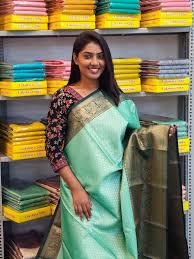Uncategorized
Exploring the Diverse Types of Sarees in India
Introduction
The saree stands as one of the most iconic and timeless garments in Indian fashion. This versatile piece of clothing can be draped in numerous styles, each reflecting the rich cultural heritage and traditions of different regions in India. This blog explores various types of sarees, highlighting their unique features, origins, and the craftsmanship involved in creating these beautiful garments.

1. Banarasi Saree
- Origin: Varanasi (Banaras), Uttar Pradesh
- Description: Artisans craft Banarasi sarees from finely woven silk and decorate them with gold and silver zari. These sarees symbolize luxury and people often wear them during weddings and special occasions.
- Key Features: Heavy embroidery, intricate patterns, and a glossy finish.
2. Kanjivaram Saree
- Origin: Kanchipuram, Tamil Nadu
- Description: Kanjivaram sarees, renowned for their durability and vibrant colors, come woven from pure mulberry silk. They often feature contrasting borders with temple designs, checks, stripes, and floral patterns.
- Key Features: Rich silk, broad borders, and traditional motifs.
3. Chanderi Saree
- Origin: Chanderi, Madhya Pradesh
- Description: Chanderi sarees, known for their lightweight and sheer texture, come woven from silk, cotton, or a blend of both. Artisans adorn them with geometric patterns and traditional motifs like peacocks and florals.
- Key Features: Lightweight fabric, elegant motifs, and a glossy finish.
4. Bandhani Saree
- Origin: Gujarat and Rajasthan
- Description: Bandhani sarees, created using a tie-dye technique, feature vibrant and colorful patterns. The fabric gets tied in small knots before dyeing, resulting in unique designs.
- Key Features: Bright colors, distinctive tie-dye patterns, and lightweight fabric.
5. Patola Saree
- Origin: Patan, Gujarat
- Description: Patola sarees showcase intricate double ikat patterns. These sarees, highly valued for their complexity and precision in design, often feature geometric and folk motifs.
- Key Features: Rich colors, intricate double ikat patterns, and a high level of craftsmanship.
6. Paithani Saree
- Origin: Paithan, Maharashtra
- Description: Paithani sarees, known for their luxurious silk and elaborate zari borders, often feature peacock motifs, floral designs, and vibrant colors, making them popular for festive occasions.
- Key Features: Rich silk, gold zari work, and traditional motifs.
7. Tussar Silk Saree
- Origin: Bihar, Jharkhand, and West Bengal
- Description: Tussar silk sarees, made from silk produced by the Tussar silkworm, have a rich texture and natural golden sheen. These sarees often feature tribal art and motifs.
- Key Features: Natural texture, subtle sheen, and lightweight.
8. Pochampally Saree
- Origin: Bhoodan Pochampally, Telangana
- Description: Pochampally sarees, famous for their geometric ikat patterns, get woven using a unique tie-dye technique that creates intricate designs on both silk and cotton fabrics.
- Key Features: Geometric patterns, bright colors, and a smooth texture.
9. Kasavu Saree
- Origin: Kerala
- Description: Kasavu sarees, also known as Kerala sarees, traditionally come in white or off-white with golden borders. These sarees symbolize elegance and people often wear them during festivals and important cultural ceremonies.
- Key Features: Simple yet elegant, white/off-white color with golden borders.
10. Mysore Silk Saree
- Origin: Mysore, Karnataka
- Description: Mysore silk sarees, known for their pure silk fabric and minimalistic designs, often feature plain bodies with contrasting zari borders and pallu.
- Key Features: Pure silk, smooth texture, and minimalistic elegance.
Conclusion
The diversity of sarees in India reflects the country’s rich cultural heritage and artistic traditions. Each type of saree has its unique charm and significance, making it a timeless piece of clothing cherished by women across generations. Whether it’s the luxurious Banarasi, the vibrant Bandhani, or the elegant Kasavu, sarees continue to symbolize grace, beauty, and tradition in Indian fashion. Embrace the beauty of these traditional garments and celebrate the artistry and craftsmanship that goes into creating each exquisite piece.